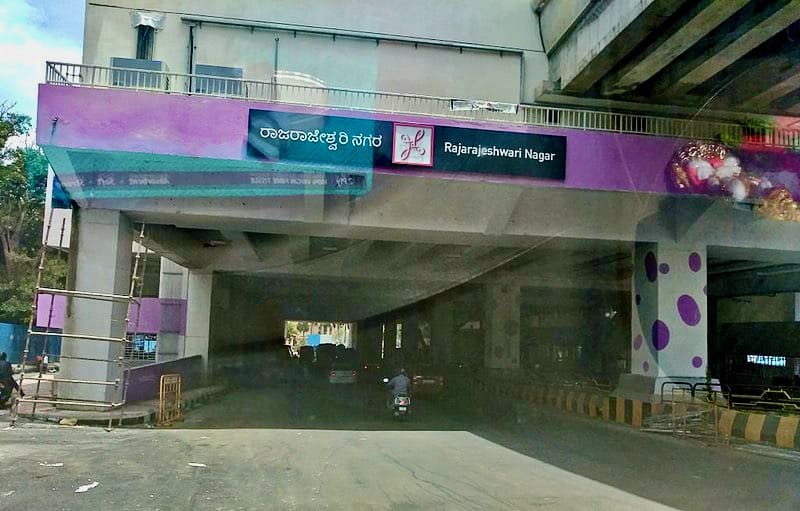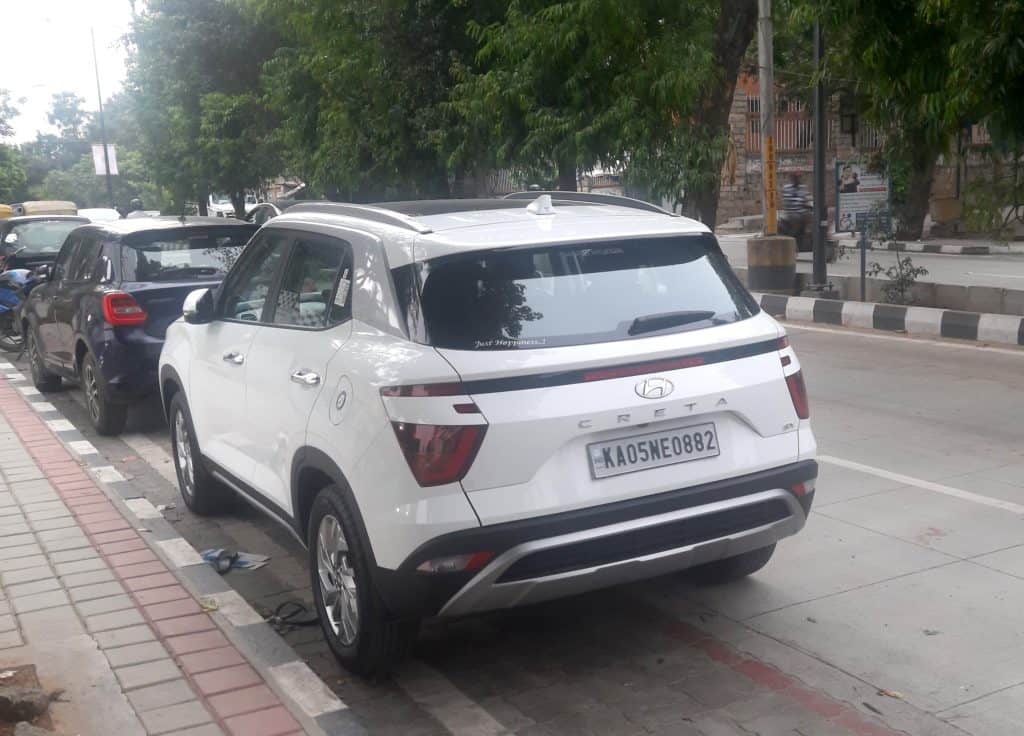I have been a regular commuter on Namma Metro since 2017 when Namma Metro’s phase one was inaugurated with connectivity to southwest Bengaluru. Two lines, the Purple Line** and Green Line were opened with an interchange at Majestic. I used to take the Purple Line from Mysore Road initially. Now I travel from Raja Rajeshwari Nagar to Cubbon Park/ MG Road almost daily.
At the time the two metro lines became operational, the hope was that this would help reduce air pollution and congestion along with the catchment areas of these routes.
Hopes that have been totally belied because of two factors, the complete lack of first and last-mile connectivity to the metro stations and the lack of coordination between BMRCL and BMTC.

How good a neighbourhood is Raja Rajeshwari Nagar?
Raja Rajeshwari Nagar or RR Nagar as it is popularly known is an upmarket locality in southwest Bengaluru. In recent times, it has also emerged as an alternative to Gandhi Nagar given the proliferation of film production and post-production houses. It has an active residents’ welfare association, which has helped revive lakes in the locality, increase awareness around waste management and segregation at source as well as preserve the verdancy in the area. Metro connectivity is an added advantage.
Given all of this, one probably would think living here would be comfortable and convenient. One couldn’t be more wrong.
The roads are pot-holed-ridden and unsegregated garbage is dumped all over the place. There is a complete lack of coordination between civic agencies, water supply woes, and cars and bikes parked in a haphazard manner, which causes jams. Bus connectivity is there only in some parts of the locality.
Read more: Better mobility design can encourage the use of public transport, cycling and walking
Metro’s missing connectivity links
The last two issues have exacerbated the first and last-mile connectivity problems. This is a key aspect of urban transport that is completely missing when it comes to Bengaluru’s transport scenario.
Let us look at my daily schedule to understand how this could have saved precious time. I have access to three metro stations given the location of my residence. However, getting to each of these has a few pain points, which I describe below.

- RR Nagar Metro Station: This is the most accessible of the three. The road leading up to the arch was recently white-topped and could be a breeze to drive if vehicles are not parked on both sides. Both sides of the road are blocked due to parked cars which leads to frequent traffic jams. It would greatly save our time if this menace is tackled by providing paid parking on this road. The station also has a decent parking lot. However, more often than not, it is difficult to find a parking slot as there is no dedicated space for two-wheelers and cars. The parking attendants insist that we do not lock our vehicles as they feel it would restrict the movement of cars. They are also insolent and abusive. I have been at the receiving end on more than one occasion. So why would anyone want to brave all this and use the Metro when probably taking the bike to the office would be much easier and quicker?

2. Pattangere Metro Station: This is a small station and has limited parking space only for two-wheelers. The station lies on Mysore Main Road and is a 3 km walk one way, which would help me burn my adipose tissues. However, given that most of the time we are carrying laptops, it becomes difficult to walk this distance. Also, the area around the metro station is poorly lit and safety is a concern once it gets dark. In fact, BBMP has not installed a single street light beyond Gopalan Mall. The thinking seems to be that this entire stretch is still beyond BBMP limits. This may have been the case 20 years ago but is no longer the case today since the metro has made its way to Kengeri. The road leading up to this station from my residence is in a poor state and nobody would want to ride a two-wheeler to get to this station.
3. Kengeri Bus Stand Metro Station: The last but one station on the Purple Line is well designed and neat. It also has the option of commuters being able to use the parking facility offered by BMTC’s Travel and Transit Management Centre (TTMC). However, the station is located around 200m from the TTMC and buses keep going in and out of the TTMC, which actually presents a very big risk. The issues of pothole-ridden approach roads and poor lighting hold true for this Metro station as well.
Read more: Dear Govt of Karnataka, Don’t let Metro and BMTC put kerchief!
Good connectivity requires multi-modal transport
I think BMTC and app-based taxi providers could do their bit to address this issue. However, there seems to be no will to do so from either side. Bus frequency is extremely low after 6 pm and the routes are poorly planned. For instance, most BMTC buses leaving RR Nagar Metro seem to be headed towards RR Nagar Bus Depot located in BEML Layout. There are umpteen regular buses to this locality. Instead, the bus from RR Nagar Metro should go to the other end of RR Nagar Main Road. This would cover a larger catchment area. Earlier, there were a few buses going to Global Village from Mysore Road Metro. However, their numbers seem to have declined post-COVID. In any case, the service is almost non-existent beyond 6 pm.
App-based taxis and autos are almost always not willing to ferry us to the nearest Metro. My office is around 2.5 kilometres from both Cubbon Park and MG Road Metro stations. More often than not, I walk as it is next to impossible to get a cab to these stations and the bus stops too are far from the Metro Station.
A lot of the issues surrounding first and last-mile connectivity could be addressed if there is coordination between the agencies. For a few months, we had a hail taxi system at Mysore Road station by Sit and Go, an electric vehicle-based last-mile solution, which greatly alleviated these woes. However, they do not seem to be operating now. This connectivity issue is one of the main reasons why many prefer to use their personal vehicles.
What can fix our last-mile connectivity woes?
1. Taxis and autos:
We need cabs and auto-rickshaws (app-based or ride-hailing ones) at the Metro stations. Metro needs to provide dedicated auto and taxi stands at its stations. Most stations in Mumbai still have the old yellow and black taxis. Ola and Uber too could work out something with Namma Metro
2. BMTC:
While buses may not take you right up to the doorstep, they do have an important role to play when it comes to reducing the number of private vehicles on the road. Commuters need to be consulted before new routes are announced and changes made accordingly. Route-based information should be provided both on the BMTC and BMRCL websites.
3. Technology:
We pride ourselves on being the Silicon Valley of Asia. But, how much technology have we actually imbibed? As someone who used BMTC’s GPS-based app during the pre-COVID days, I can vouch that the information was not up to date. The app’s user interface and design too left a lot to be desired. It is quite easy in a city like Bengaluru to ensure that digital screens are installed within Metro stations with information on bus routes. GPS can be further used to provide real-time tracking and information to commuters.
4. Walkable roads:
Last but not least, it is necessary that our roads become more pedestrian-friendly. Most pavements are broken or you find two-wheelers and cars parked there. It is also not uncommon to find two-wheeler riders using the pavements to overtake stalled traffic. Bengaluru traffic police have an important role to play in ensuring that the roads become safe for pedestrians.
The way forward for public transport policy
Seamless commute and congestion-free roads will remain a mirage if the crucial issue of last-mile and first-mile connectivity along with multi-modal transport continues to be ignored.
The National Urban Transport Policy 2014, recommends the formation of a Unified Metropolitan Transport Authority (UMTA). The first steps for the same were undertaken by DULT (Directorate of Urban and Land Transport), which is part of the Transport Ministry of Karnataka way back in 2007.
A right step was taken last year in terms of drafting the Bengaluru Metropolitan Land Transport Authority bill but there has been little action on the ground.
However, there has been no formal public consultation on this bill, though it is something that impacts the public at large. The main purpose of the bill is to bring about coordination between the stakeholders such as BBMP, BDA, BMRDA, BDA, BMTC and BMRCL. Curiously, the draft version of the bill does not mention KRIDE or Bengaluru Suburban Rail Company. This to my mind is a lacuna that needs to be addressed. A UMTA cannot work without the inclusion of the Suburban Railway.
The BMLTA bill is also unclear on how it would aim to increase the share of public transport. In short, the intent to create a sustainable development model or address the larger goal of mitigating climate change locally. The bill is also reticent on issues such as Non-Motorised Transport, Multi-Modal Transport and parking.
**Errata: The Purple Line of the Metro had been erroneously referred to as the Pink Line in the first published version of the article. We regret the error and have made corrections in all the references to it.
Amith has hit the nail on the head. The issues raised are not new. Why not these agencies realize that running busses on routes like this contributes to increased revenue. I use the metro regularly from Pattanagere but parking my car near by is a nightmare since BMRTCL conveniently ignored this aspect. What emerges is single lack of coordination and the mindset of not doing anything.
Please correct the above article that it is purple line metro not pink line, a person traveling from 2017 cannot commit a mistake, its a blunder. Pink line is yet to be constructed and operationalized.